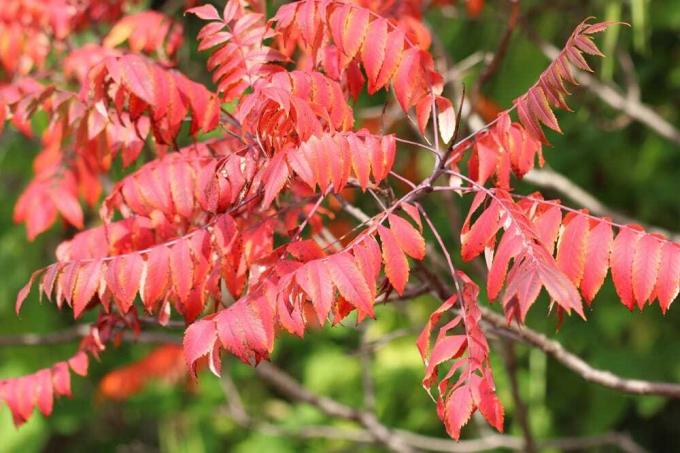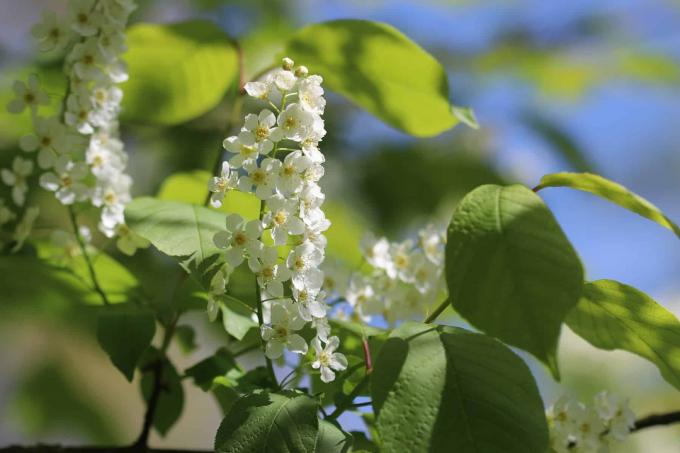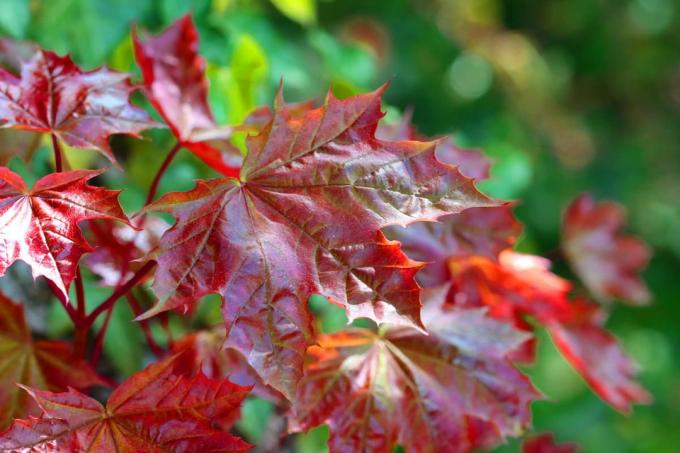

Table of contents
- Degree of toxicity disputed
- ingredients and effects
- effect on people
- Help with poisoning
- Endangerment for pets and grazing animals
- dogs and cats
- hamsters and guinea pigs
- horses and sheep
- symptoms and remedies
- risk of confusion
Rhus typhina, also known as stag's butt sumac, grows as a deciduous shrub or small tree with several stems and can grow to a height of up to 500 cm. It flowers in early summer after the leaves have sprout. However, it spreads very quickly and can easily crowd out neighboring plants. But what about the toxicity of this plant, is it poisonous and if so, for whom?
Degree of toxicity disputed
The confusion about the toxicity of Rhus typhina is believed to be due to other species of the genus Rhus that cause poisoning, such as poison sumac (Rhus toxicodendron). It contains so-called urushiols, which can trigger severe allergic reactions on contact. At the deer butt sumac (Rhus typhina) no urushiols could be detected.
It owes its name to the fruit, which contains an acid that tastes of vinegar. However, while the flowers are not poisonous, the fruit should only be used when processed. They are mainly used dried as a refreshing tea or spice for the production of "Indian Lemonade" lemonade or pickled in vinegar.
The milky juice it contains is particularly toxic. Contact and consumption can trigger different reactions. This applies to humans as well as dogs, cats, small animals and horses. In most cases, it only becomes critical if larger amounts are taken, because it is known that the dose often determines the toxicity.
ingredients and effects

The ingredients include tannins, essential oil, resins, steroids, phenylglycosides and triterpenes. The main active ingredients are tannins, ellagic acid and a highly acidic cell sap. The actual poisonous effect of the vinegar tree is based on the latter. They can cause different symptoms depending on the dose.
effect on people
- Poisoning predominantly by milky juice of the plants
- Skin contact may cause skin irritation in sensitive individuals
- If juice gets into the eyes, it can cause conjunctivitis
- When consumed, the amount of poison is particularly important
- Only ingestion of large amounts of leaves or fruits is hazardous to health
- Symptoms such as stomach pain, diarrhea, nausea, vomiting, headache and dizziness
- In the worst case, damage to the kidneys and liver is possible
- Children, the elderly and the sick are particularly at risk
- It is best to avoid contact with this plant
Tip:
Unlike children, healthy adults usually do not have to worry about symptoms of poisoning when consuming small amounts.
Help with poisoning
If children are affected, they should definitely be contacted promptly Physician to be introduced. In case of eye contact, it is advisable to consult an ophthalmologist immediately. A call to the poison control center is also helpful.
Endangerment for pets and grazing animals
For grazing animals, a wide variety of plants and herbs offer variety when feeding. However, there are some plants that can cause poisoning in animals, such as stag's butt sumac (Rhus typhina). Many plants that are non-toxic to humans can be toxic to animals. The effects can vary from animal species to animal species and affect both domestic and small animals as well as grazing animals, in this case horses in particular.
dogs and cats
Parts of the vinegar tree are slightly poisonous for dogs. Poisoning manifests itself in the form of gastrointestinal complaints such as nausea, vomiting and diarrhea. This tree, especially seeds, unripe fruits and roots pose a greater danger to cats. In addition to gastrointestinal problems, they can also suffer from paralysis and even death as a result of respiratory or circulatory paralysis. This is mainly due to the tannins and acids contained in the plant. If any symptoms appear, a veterinarian visit should be made.
hamsters and guinea pigs

Hamsters, guinea pigs and other small rodents are at similar risk to cats, although rabbits, rats and mice tolerate significantly higher doses. Depending on the amount consumed, the symptoms can also vary in severity. Gastrointestinal problems can occur in cats, hamsters and guinea pigs. In addition, weakness can occur. A visit to the vet is also recommended for these animals.
Tip:
In order to make the diagnosis easier for the veterinarian, it is advisable to take part of the plant with you. Incidentally, this applies to all animal species and all poisoning caused by plants.
horses and sheep
As far as sheep are concerned, poisoning by this plant is said to be unknown. If you want to be on the safe side, you should not feed vinegar tree leaves to sheep. However, they are definitely poisonous to horses. They spend most of the day eating. Through domestication, most domestic horses have lost their natural instinct to avoid poisonous plants. Poisoning can occur on the pasture or in the stable if parts of the vinegar tree accidentally get into the hay.
This can lead to minor or serious damage to health, especially in horses, and in the worst case even to death. Not all animals react in the same way, some are much more sensitive than others. A decisive factor here is the health and nutritional status of the animals. Of course, poorly fed and ailing horses are more sensitive because they have nothing to counteract the poison.
symptoms and remedies
- In case of poisoning, occurrence of gastrointestinal problems
- Severe colic is also often possible
- Milky juice can also cause inflammation
- Contact a veterinarian immediately for clarification and treatment
- Provide as much information as possible on the phone
- When the horse ate what and how much of it
- What symptoms it shows, how it behaves
Tip:
If necessary, the veterinarian can give some helpful advice on first aid over the phone. Until he gets there, give the animal plenty of water to drink.
risk of confusion
The deer butt sumac (Rhus typhina) will be partly with the tree of heaven (Ailanthus altissima) mistaken. Both the seeds and the bark of the tree have poison potential. The leaves and pollen are also suspected of triggering allergies. However, there are clear characteristics that can be used to distinguish these two trees.
Deer butt sumac(Rhus typina)
- Growth height up to five meters
- 11-31 oblong-lanceolate leaflets
- Edges of the leaflets serrated
- Shoots velvety hairy
- Male flowers with yellowish-green petals
- Females with reddish petals
- Dark red, flask-like infructescence
tree of gods(Ailanthus altissima)
- Height of growth up to thirty meters
- 20-40 leaflets, up to 90 cm long
- Leaf margin has a tooth
- Inflorescence whitish-green
- Intense, unpleasant smell
- Two-sided winged infructescence
- Parchment-like, light brown to reddish wings
Tip:
There is also a risk of confusion with the highly poisonous relatives of the vinegar tree from the sumac family, such as poison sumac. The non-poisonous common ash tree is confusingly similar to it.
References:
https://de.wikipedia.org/wiki/Essigbaum
https://www.mein-schoener-garten.de/abc/e
https://www.baumkunde.de/Rhus_typhina/
http://www.gartendatenbank.de/wiki/ailanthus-altissima
https://botanikus.de/informatives/giftpflanzen/alle-giftpflanzen/essigbaum/
https://www.pflanzen-vielfalt.net/b%C3%A4ume-str%C3%A4ucher-a-z/g%C3%B6tterbaum/
 Home editorial office
Home editorial office
Learn more about Baumlexikon

Bird cherry, Prunus padus: caring for, pruning & propagating
The bird cherry is a shrub or tree that is the ideal bee pasture in a natural garden. However, the plant should also be viewed with caution, as it is a poisonous plant for horses. Nevertheless, it is popular in the local colorful hedges.

Red maple: 9 tips for caring for, cutting & overwintering
The red maple is one of the most impressive trees in Germany due to its unusual scarlet leaf colour. Here you can find out how to integrate this impressive plant into your garden and how to keep it healthy and vigorous.

Sycamore tree: Properly care for and cut sycamore trees
The plane tree (Platanus) has a high decorative value. In terms of care, it is mostly undemanding, which is why it is often chosen as a street tree. Nevertheless, there are a few details to be observed when it comes to care, as described in the home garden guide.

Birch locations: 5 important criteria
Birch trees are extremely frugal trees and are particularly eye-catching and decorative thanks to their light-colored bark. When choosing a location, however, a few factors should be considered in order to create optimal conditions for their growth and to protect the environment.

Cutting dwarf pine - instructions for the perfect cut
Dwarf pines can be pruned by thinning out, topiary or limbing. A bonsai design with needle and root pruning is also possible. So that the wood does not look unattractive after the pruning measure, a few rules of technology should be observed.

Vinegar, Rhus typhina | Care from A – Z
The vinegar tree is an easy-care plant for the garden and tub with a special autumn color. Only its uncontrolled spread can lead to problems in the garden. However, this can be curbed with a root barrier.

